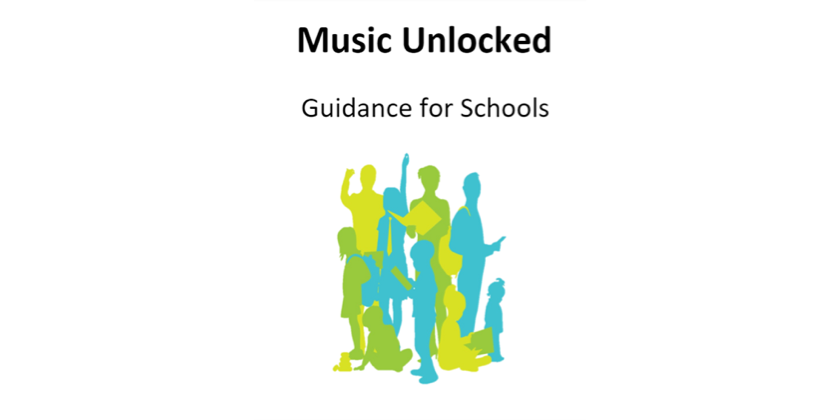Music Unlocked: Guidance for Schools
This guidance is intended to inform school leaders in planning and risk assessing musical activity in schools. Updated on 21st March 2022.

On this page
Making Music Safely in School
This guidance is intended to inform school leaders in planning and risk assessing musical activity in schools. It is based on guidance from Music Mark, the former Federation of UK Music Services and more recently DE Education Guidance for Schools.
Schools should be mindful of the COVID guidance that applies to children and young people in lives outside of school and ensure that their activities in school are able to be managed using similar principles, where possible.
Visiting teachers (including project staff) can be welcomed into schools provided that they adhere to mitigations that are in place in each host school on minimising the spread of COVID-19; they can teach in multiple schools and across classes with mitigations (a COVID-19 Code of Practice for EA Music Service staff accompanies this document).
Whilst every effort has been undertaken to verify the information used to write this document and to relate that specifically to musical learning for children and young people in and out of school, the Music Service cannot be held accountable for any advice given which subsequently is proven to be inaccurate.
This guide presupposes that schools are already complying with DE Education Guidance for Schools
Considerations for the Music Service and schools
There are a number of factors schools should consider as they welcome visiting teachers back into their buildings. The Music Service will work closely with all schools to agree appropriate protocols. We will respect each school’s individual arrangements and risk assessment for safeguarding pupils and visitors.
It is appreciated that some pupils attending SEN schools or those with additional needs may need assistance, required at times from other adults. SEN schools and EA Music staff should work closely together, considering how best to safely implement these, taking into consideration the needs of the pupils and the support provided to them.
Peripatetic instrumental and vocal lessons
Individual and small group lessons should be held in rooms that can be ventilated well. Positioning of pupils/tutors should be side to side or back to back, avoiding playing face to face.
Mouth-blown instruments should never be shared.
Instrumental and vocal ensembles (including choirs)
Instrumental and vocal ensembles should rehearse in well-ventilated rooms. Seating plans should enable pupils to keep their distance from each other wherever possible and playing/singing face to face should be avoided. There is no longer a requirement to wear face coverings in post-primary schools in rehearsal halls/classrooms, but it is recommended that face coverings are worn in corridors, communal areas and on public and school transport.
Live music performances
In the organisation of concerts, plays and performances on school premises, schools should continue to be vigilant in relation to the need to ensure mitigating measures are in place to reduce the risk of virus transmission. Ventilation should be maximised where possible, and schools should consider any relevant mitigations if they wish to offer hospitality such as tea/coffee before, during and after a performance. Other possible mitigations may include the wearing of face coverings and the use of school risk assessments to determine appropriate audience capacity.
Performances held in venues outside of schools, such as in public concert halls, should adhere to the COVID mitigations that are operated by that venue.
Conclusion
Music is more necessary than ever to children’s broad and balanced education. The wellbeing benefits seen by many music education providers during lockdown will be ever more needed as children return to school and process their experiences.
The Music Service management and staff have returned to music making, engaging and working alongside schools to create the safest learning environment possible for all our children and young people.
COVID-19 Code of Practice Protocols for the EA Music Service
Please see below the protocols that EA Music Service tutors must have in place in order to teach in EA schools. We also ask that EA staff liaise with schools to ensure the safety and well- being of pupils, EAMS tutors and school staff.
Please see the protocols listed below.
EAMS should:
- ensure that EAMS Tutors do not attend school if they exhibit COVID-19 symptoms or have been asked to self-isolate. A line manager/office will notify schools in accordance with EAMS guidance.
- ensure that the EAMS Tutor follows current EA and PHA procedures if they test positive for COVID-19.
- encourage EAMS Tutors to maintain contact with schools for up-to-date information on possible disruptions to their teaching schedule (school staff/website etc)
- highlight the need for EAMS Tutors to familiarise themselves with the working arrangements in each school.
- adhere to school policies, which are paramount.
EAMS Tutors should:
- sign in at the school reception on arrival, sanitising/washing hands before and after signing in.
- wear a face covering while in transit through the school building.
- ensure that pupils are never face to face during lessons and ventilate the room by opening a window or doors where necessary.
- provide timetables that are appropriate to the schools’ needs and COVID-19 protocols.
- only play on their own instrument and never share mouthpieces.
- make themselves aware of assembly points in the event of an emergency
Where a child who is taught by an EAMS tutor tests positive for COVID-19, the tutor should follow guidance given to them by the school and inform their designated line manager.
Schools should:
- provide a teaching environment appropriate to the group size and EAMS guidance.
- communicate expectations to EAMS Tutors and changes to school working patterns in response to COVID-19 protocols.
Download the full document
The full document includes risk assessments as well as the guidelines and protocols.

MS Guidance for Schools V22.pdf
MS Guidance for Schools V22.pdf